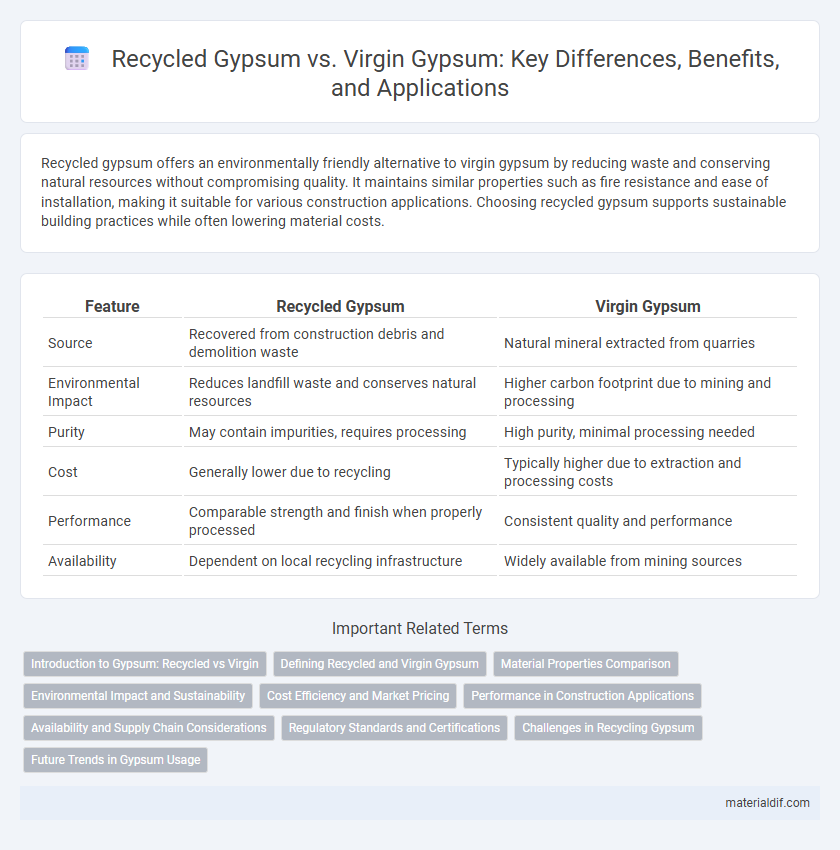Recycled gypsum offers an environmentally friendly alternative to virgin gypsum by reducing waste and conserving natural resources without compromising quality. It maintains similar properties such as fire resistance and ease of installation, making it suitable for various construction applications. Choosing recycled gypsum supports sustainable building practices while often lowering material costs.
Table of Comparison
| Feature | Recycled Gypsum | Virgin Gypsum |
|---|---|---|
| Source | Recovered from construction debris and demolition waste | Natural mineral extracted from quarries |
| Environmental Impact | Reduces landfill waste and conserves natural resources | Higher carbon footprint due to mining and processing |
| Purity | May contain impurities, requires processing | High purity, minimal processing needed |
| Cost | Generally lower due to recycling | Typically higher due to extraction and processing costs |
| Performance | Comparable strength and finish when properly processed | Consistent quality and performance |
| Availability | Dependent on local recycling infrastructure | Widely available from mining sources |
Introduction to Gypsum: Recycled vs Virgin
Recycled gypsum originates from construction and demolition waste, processed to remove impurities and restore its chemical composition, making it a sustainable alternative to virgin gypsum. Virgin gypsum is quarried directly from natural deposits, offering high purity and consistent quality essential for manufacturing drywall, plaster, and cement. Comparing recycled and virgin gypsum highlights differences in availability, environmental impact, and cost-efficiency, influencing selection in construction applications.
Defining Recycled and Virgin Gypsum
Recycled gypsum is derived from processed construction and demolition waste, ensuring sustainability by repurposing materials that would otherwise go to landfills. Virgin gypsum, extracted directly from natural mineral deposits, offers high purity and consistent chemical properties essential for traditional manufacturing. Understanding the distinction between recycled and virgin gypsum is crucial for selecting the appropriate material based on environmental impact and performance requirements.
Material Properties Comparison
Recycled gypsum typically retains 85-95% of the purity level found in virgin gypsum, ensuring comparable calcium sulfate dihydrate content essential for setting and strength. While virgin gypsum offers consistent particle size and moisture content, recycled gypsum may present slight variations that can affect workability and drying times in plaster and drywall applications. Both materials provide similar fire resistance and thermal insulation properties, though recycled gypsum's environmental benefits make it a sustainable alternative without significant compromise in performance.
Environmental Impact and Sustainability
Recycled gypsum significantly reduces landfill waste by diverting construction debris and lowering the demand for virgin gypsum extraction, which depletes natural resources and involves energy-intensive mining processes. The recycling process emits fewer greenhouse gases, contributing to decreased carbon footprints and promoting circular economy principles in the construction industry. Utilizing recycled gypsum enhances sustainability by conserving raw materials and minimizing ecological disruption, reinforcing the sector's commitment to environmental stewardship.
Cost Efficiency and Market Pricing
Recycled gypsum offers significant cost efficiency compared to virgin gypsum by reducing raw material expenses and minimizing landfill fees, making it an attractive option for sustainable construction projects. Market pricing for recycled gypsum generally undercuts that of virgin gypsum due to lower processing costs and the growing demand for eco-friendly building materials. As recycling technology advances, the price gap between recycled and virgin gypsum is expected to widen, further promoting the adoption of recycled gypsum in cost-sensitive markets.
Performance in Construction Applications
Recycled gypsum maintains comparable performance to virgin gypsum in construction applications, offering similar durability, workability, and fire resistance. Studies indicate recycled gypsum can achieve equivalent setting times and strength, making it suitable for drywall and plaster production. Its enhanced sustainability credentials provide an eco-friendly alternative without compromising structural integrity or finishing quality.
Availability and Supply Chain Considerations
Recycled gypsum offers increased availability by utilizing waste materials from construction and demolition, reducing dependence on finite natural gypsum deposits. The supply chain for recycled gypsum can be more localized, shortening transportation distances and lowering costs, though quality consistency may vary. Virgin gypsum relies on established mining operations with predictable supply but faces risks from resource depletion and regulatory restrictions impacting long-term availability.
Regulatory Standards and Certifications
Recycled gypsum must meet strict regulatory standards such as ASTM C1396 and EN 520 to ensure safety and quality comparable to virgin gypsum used in construction. Certifications like GREENGUARD and LEED credit compatibility are crucial for recycled gypsum products, facilitating their acceptance in sustainable building projects. Compliance with these regulatory frameworks guarantees recycled gypsum maintains performance integrity while promoting environmental stewardship.
Challenges in Recycling Gypsum
Recycled gypsum faces significant challenges such as contamination with impurities like paper, metals, and other construction debris, which complicate the purity and usability of the material. The presence of these contaminants requires advanced separation and cleaning technologies to restore the recycled gypsum to a quality comparable to virgin gypsum. Furthermore, limitations in current recycling infrastructure and inconsistent supply chains hinder the large-scale adoption of recycled gypsum in construction and manufacturing.
Future Trends in Gypsum Usage
Recycled gypsum is anticipated to play a significant role in the future of sustainable construction, reducing landfill waste and lowering carbon emissions compared to virgin gypsum extraction. Advances in recycling technology enhance the purity and usability of recycled gypsum, making it increasingly competitive with virgin gypsum in drywall production and plaster applications. Market demand for eco-friendly building materials and government regulations support the growing adoption of recycled gypsum, driving innovation and expanding its use in modern construction projects.
Recycled Gypsum vs Virgin Gypsum Infographic

 materialdif.com
materialdif.com